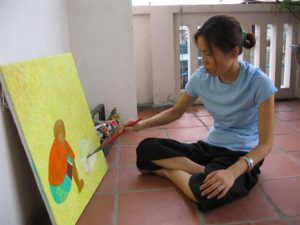Statement
At the beginning, one sees nothing. A whole of things is seen, but nothing is seen, or rather, one sees like everyone else. What is necessary, is a long meditation process, pencil in hand. And at the end, one realises that things start to have another truth. Reality appears much truer. This requires much time
 « Edouard Pinion, the Search of Reality »
« Edouard Pinion, the Search of Reality »
Have you ever had the feeling you were swallowed in by the whirls of urban life rushing at an accelerated and vertiginous rate, in a dusty and polluted atmosphere, in the midst of competition and ambition? Tired, exhausted, overpowered by headaches, have you ever felt suddenly guided by the desire to be in a quiet and peaceful landscape?
There, you rediscover herons and the moon from your childhood‘s tales, sometimes even the sounds of flute lavished by buffalos herders or the whistling of a stormy wind bringing you to relive Beethoven’s sixth symphony (also known as the pastoral symphony). And you might be transported back in your childhood memories even if you did not spend your first years in the countryside.
This describes the impression I got when I first looked at Ta Thi Thanh Tâm’s paintings. Her topics are simple: children sitting on the backs of buffalos, daily country life such as playing ball, kiting, festive meals on banana leaves, rendez-vous under the moonlight, concerts, bonzes, novices and pagodas,etc. These are an illustration of popular tales.
These pictures are painted with love and extreme simplicity. Space becomes two-dimensional. The strikes are gracious, owing neither to the pastoral theme nor to the painter‘s technique, but rather being the reflection of the artist‘s pure mind. Tâm overcame more than once the problems marking out the course of her life. Handicapped by the after-effects of the poliomyelitis she suffered from during her childhood, Thanh Tâm once thought of seeking serenity in the shadow of Buddha. Her pious idea would have become reality, if an old friend of the family, the painter Dinh Minh had not discovered her vocation and her natural talent for painting. This explains why bonzes and pagodas have become the artist‘s favourite topics.
« From a very young age, I was always attracted by traditional Vietnamese paintings and always dreamed of being able to paint them one day. The dream became reality. Combining the traditional and modern techniques, I reinforce the fundamental topic while placing the protagonists on a flat and open background. At first glance, my paintings may appear very simple and naive. But if you take a closer look, you will be able to discover much more meaning » says Tâm.
Since then, painting has become a refuge for her heart. This may appear strange but Thanh Tâm admits: « I must say that I am grateful for my sleepless nights. Indeed, each one of them brings me inspiration for a new creation ». Art gave Thanh Tâm the serenity that she needs. Thanks to the lighting of the subtle conscience invested in the depth of her works, she, in turn, can forward this serenity to spectators. Art, in a certain way, appears like the Buddhist Temple to Tâm‘s eyes.
Biography
Ta Thanh Tâm was born in 1960 in Hanoi.
She is graduated from the Hanoi Fine Arts College in 1993.
Member of Hanoi Fine Arts Association.
Exhibition of her paintings in many countries, i.e. Vietnam, Denmark, Switzerland and USA.
With her paintings in lacquer, Tâm dwells on people’s life, inspired by people and traditions of the Red River Delta. Her inspirations roots from oriental philosophy, Buddhism. Pagodas, days Tâm, are a symbol of tranquility and provide an avenue of escape for most people from their mundane lifestyles. Adopting a fairly simplistic painting style, Tâm often reinforces a painting’s fundamental theme by placing the protagonist on a plain background.
Tâm seeks to convey the genuine emotion of people living in local villages through her art, thereby showing them in their natural light. Emotion-positive or negative-stands out in all of Tam’s paintings, a deliberate tactic she will to go great lengths to point out. She says she wishes to amaze audiences with an innovative use of color and a complexity of images. She uses modern techniques, but simple and basic, rooted in established engravings and wood carvings. Her colors are high and flat on plum backgrounds. Her deep black contour lines draw shapes and figures with a great presence. Everything comes down to the brush stroke and its dynamic balance, following eastern painting tradition. Tâm succeeds through her modern techniques in showing us the heart of this very Vietnamese kind of beauty. She says that her art had, in part, helped her overcome her difficulties with polio in her early childhood.













